
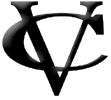 |
||
| VASSAR COLLEGE | ||
| Department of Physics and Astronomy | ||
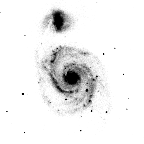
 |
|
 |
|||||||||
WLAP: the Web Lecture Archive Project
Eric Myers
Department of Physics and Astronomy
Vassar College
myers@vassar.eduPrepared for the Teaching with Technology Forum for 2004 at Vassar College
A great deal of contemporary physics knowledge is conveyed from one place to another via lectures and tutorials delivered by physicists. New research results are announced in advanced research seminars. More general physics colloquia are held explain advances in a particular field of physics or to update physicists on the status of various projects. Conferences are held to bring together specialist who share their latest research results and plans with other experts, and sometimes form new collaborations. Summer schools such as the Theoretical Advanced Summer Institute (TASI), the Scottish Universities Summer School in physics, and the CERN Student Lectures in particle physics provide tutorial lectures which give interested students a way to master a tremendous amount of new information in a short span of time. Technical training workshops give physicists the skills to use complicated software systems to collect and analyze data from the next generation of physics experiments. Physics Lectures
Traditionally, the only way one could attend these kinds of lectures or tutorials was to either travel to a conference or have the speaker travel to one's own institute. In the past few years, however, the Internet has made it possible both to attend lectures remotely in real time and to view past lectures which have been stored in an archive. This is not as good as actually being in the same room when the lecture is given, but it is better than missing the lecture or tutorial entirely.
Most physics lectures and tutorials are slide-based, either using transparancies and overhead projectors, or lately also PowerPoint presentations. It has been a challenge to be able to record the audio, video, slides, and slide change times from a lecture and to present them via a network connection with everything properly synchronized.
The World Wide Web was created by physicists to aid in long distance collaboration and to share research results. But the web worked best for text and graphics, not the complete experience of a lecture. Physics Lectures via the World Wide Web
The web made it possible for the slides from a lecture to be archived and shared across the Internet, but without audio or video. These were generally of most use to someone who had attended the lecture and wanted to go back to view a slide in more detail, or to a specialist who might be able to interpret the slide without the benefit of the speaker's description.
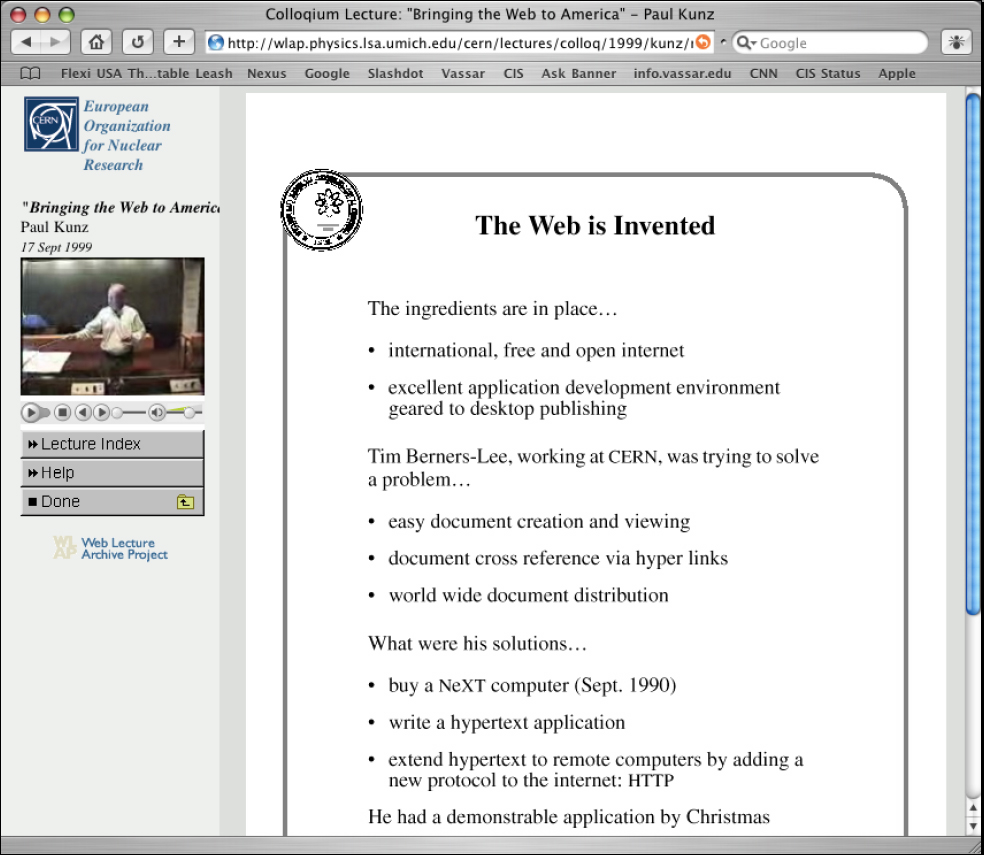
Lecture presented at CERN by Dr. Paul Kuntz of the Stanford Linear Accelerator Center on his role in the development of the World Wide Web. Early attempts to provide both lecture slides and audio were made by the Kavli Institute for Theoretical Physics at the University of California at Santa Barbara [example], and by James Liu and Eric Myers for the Strings 2000 conference at the University of Michigan. This allowed one to view the original slides while at the same time listening to the speaker delivering the talk. It was the responsibility of the listener to try to guess when to move on to the next slide. Even so, this was a great advance over just putting only the slides online.
Conncurent with those developments in the physics community, a system for streaming lectures across the Internet with synchronized audio, video and slides was developed starting in 1996 by Dr. Charles Severance, then at Michigan State University. The tool he created was called Sync-O-Matic 3000, and was originally intended for use in a computer science class on the Internet and Technology at MSU. Dr. Severance continued to work on Sync-O-Matic when he moved to the Media Union at the University of Michigan. The potential utility of this software for delivering slide-based physics lectures across the Internet was quickly recognized at U-M. A pilot project, funded by the National Science Foundation, was carried out from July to September of 1999 to use Sync-O-Matic to develop an electronic archival system for lectures, tutorials and other slide-based presentations at CERN, the European Laboratory for Particle Physics.
The success of this pilot project lead to the development of the Web Lecture Archive Project (WLAP) as a joint venture between the UM-ATLAS Collaboratory Project at the University of Michigan, the University of Michigan Media Union, and CERN. The goal of WLAP was and still is to implement an electronic archival system on the Internet for slide-based presentations like those commonly used for physics lectures, as well as to develop the software and supporting technology for creating and distributing these kinds of presentation. The Web Lecture Archive Project
Eric Myers was a member of the WLAP team at the University of Michigan until he moved to Vassar College in the summer of 2002.
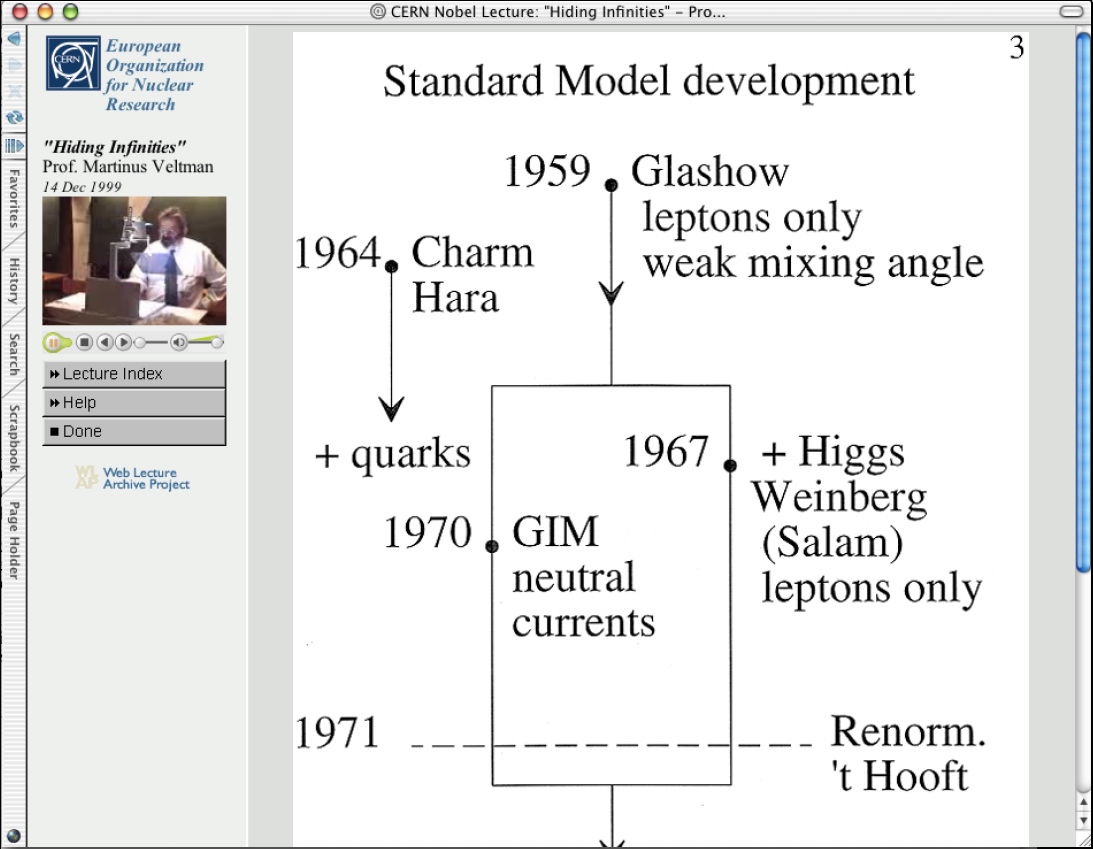
Lecture presented at CERN by Prof. Martinus Veltman on 14 December 1999, shortly after he was awarded the Nobel Prize in physics. Lectures in the WLAP archive can be viewed by anybody with an Internet connection, a web browser, and the RealPlayer plug-in. Lectures can also be downloaded and viewed later off-line, or from a CD. RealPlayer was chosen for the initial implementation because it is the only format that works easily on Windows, Apple, and Unix computers. RealPlayer also has a feature called "SureStreams™" which can serve the lecture at different bandwidths. In the future, lectures may also be available in Windows Media, QuickTime, and MPEG-4 formats.
A number of the lectures in the archive are highly technical and are used as a part of ongoing efforts to build ATLAS, a large particle physics experiment being assembled around the world for the Large Hadron Collider (LHC) at CERN. But an equally large number of WLAP lectures are accessible to undergraduate physics students, and some are even aimed at members of the general public who are interested in physics.
The WLAP archive currently contains nearly 300 lectures, covering a wide range of topics and a wide range of levels. The WLAP archive presently includes:
- CERN Summer Student Lecture series on particle physics
- Student reports on undergraduate research conducted under the UM-CERN REU program
- Saturday Morning Physics, a popular lecture series for the public from the University of Michigan
- Specialized software training for the D-zero experiment at Fermilab, the ATLAS experiment at CERN, and related particle physics experiments.
- Talks from Conferences and Workshops at the Michigan Center for Theoretical Physics
- Clinical Grand Rounds and related lectures from the Center for Advancement of Clinical Research at UM.
- A wide range of lectures on selected topics, including a Nobel laureate and a creator of the World Wide Web, explaining their work
The technology used to produce and serve these slide-based presentation is also being used separately by CERN in Switzerland and by the Fermi National Accelerator Laboratory (Fermilab) in the US.
Several other systems for streaming lectures across the Internet have been developed in the past few years, but there are a number of reasons why the syncronized system used by WLAP is superior.
The structure of the WLAP lectures puts first emphasis on the most important part of the lecture, the slides, then on the next most important part, the audio, and then on the video. It is possible to "view" WLAP lectures with only the slides and audio if network bandwidth is limited. But it has been found by informal testing that the syncronized video of the speaker, even when it is presented in a relatively small window at low resolution, greatly enhances the feeling of presence experienced by the viewer.
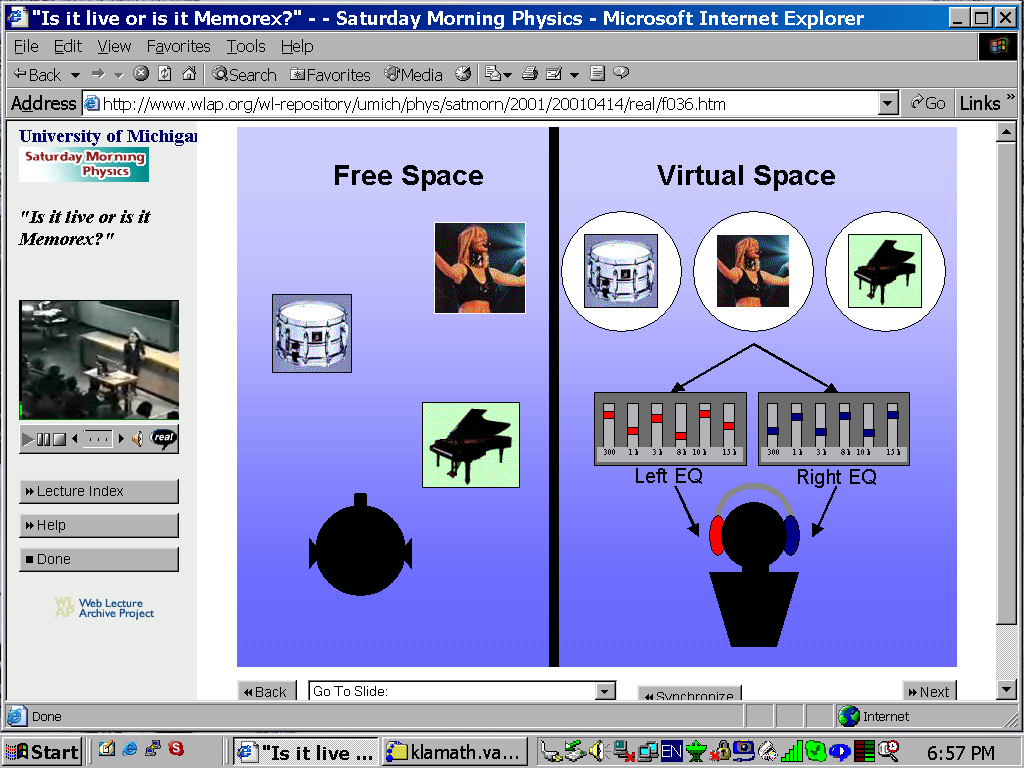
Post-Doctoral Fellow Maureen Mellody describes the intricate workings of human perception of sound in a lecture from the University of Michigan Saturday Morning Physics series. Sync-O-Matic lectures also give the viewer a great deal of flexibility during the lecture. The viewer can use buttons to move backwards or forward through the slides, even as the audio/video portion of the lecture continues. Or the viewer can find a particular slide and then re-syncronize the audio/video stream to that part of the lecture. A complete graphical index is available so that a viewer can see all the slides at once and jump to any interesting point in the lecture.
The Sync-O-Matic method of presenting on-line lectures also works well in cases where network bandwidth is limited. Since the slides are static images they load fairly quickly throughout the lecture. If bandwidth is really limited one can view the lecture index before starting the lecture, which brings all the slide images into the browse cache so that they are already loaded as the lecture progresses. If the audio/video stream is encoded using RealMedia SureStreams™ then the RealPlayer plug-in can adjust the stream during the lecture to account for congestion or some other network problems.
It is also extremely easy to copy a WLAP lecture or set of lectures to a CD so that they may be viewed without a network connections, as on an airplane or at a location where bandwidth limitations are a serious problem.
WLAP has also developed software to aid in the capture and production of Web Lectures. One useful tool is CarpePPT, which is a program for automatically capturing PowerPoint slides along with the slide change timings from a lecture. Another is Websentation, which is another program for collecting and merging slides, audio/video, and slide change timings to create a WLAP lecture. Websentation runs on any Unix-based system and represents a continuation of the development of the original Windows based Sync-O-Matic.
Physics departments at most major research universities have a weekly department colloquium, as well as more specialized weekly research seminars for each research group. Until recently, the size of our deparment and the logistics and expense of bringing a speaker to campus every week have prevented any kind of regular seminar series, though department lectures were held several times a semester at irregular intervals. WLAP at Vassar
Since the spring of 2003, however, the department of Physics and Astronomy at Vassar has held a regular weekly department colloquium, which has included lectures from faculty on their current research, lectures from students on their summer research activities, and lectures from visiting physicists from other institutions. The department colloquium series has also included recorded lectures from the Web Lecture Archive project, as well as recorded talks from Caltech and Fermilab.
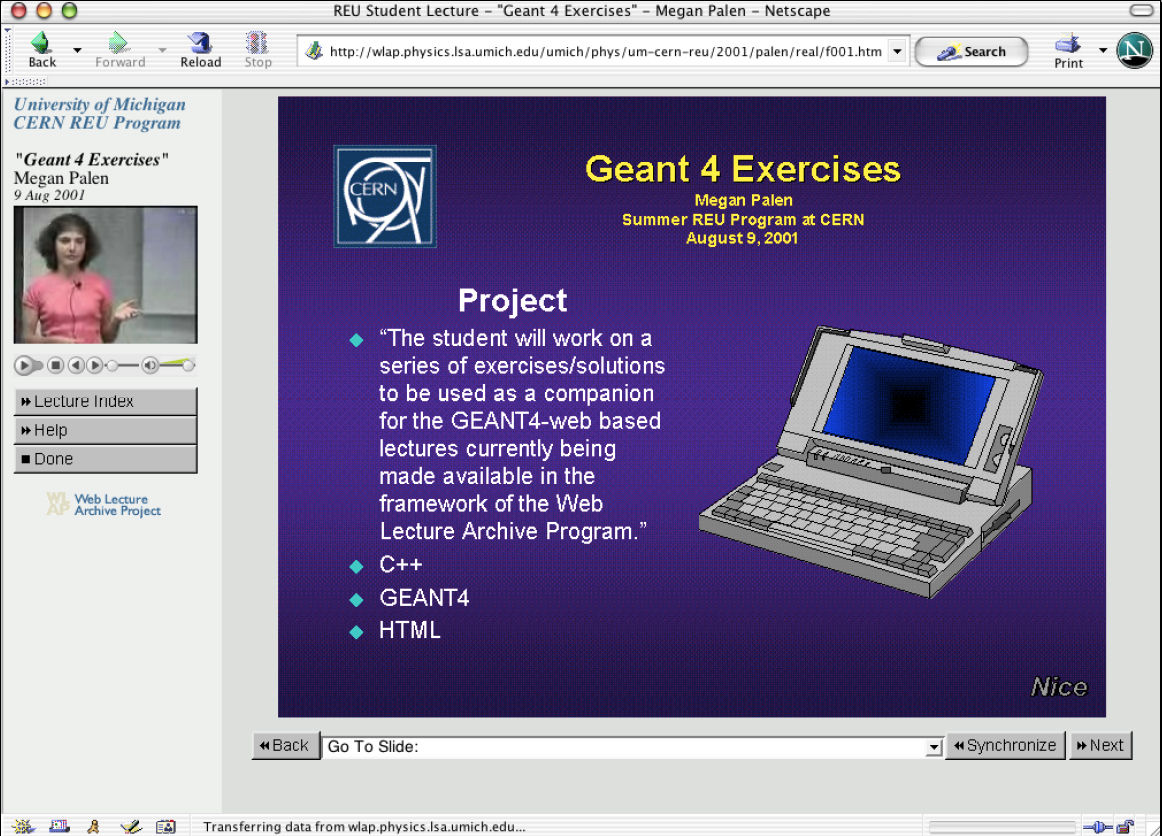
Research Experiences for Undergraduates student Megan Palen explains her summer project.
Students can also view or review the lectures in their own time from their own dorm room, the library, or any campus computing site. Students can also peruse the archive and view other lectures that they may find interesting or useful.These recorded lectures are one way that Vassar students can keep up on current developments in physics without having to leave the Vassar Campus. They make a useful suplement to classroom learning at Vassar.
The process of creating and serving lectures in this way is fairly straightforward. It would not be difficult to produce and serve lectures from Vassar. This might be useful for faculty to present research results locally and then distribute them to colleagues without having to leave campus. It would also be possible to serve talks for Vassar's Undergraduate Research Summer Institute (URSI) program, so that they may be viewed by alumni, family, and friends.
Sample Lectures
- Hiding Infinities - Professor Martinus Veltman describes the work leading to his Nobel Prize in Physics.
- Is it Live or is it Memorex? - Dr. Maureen Mellody describes the physics of hearing and perception, including an explanation of how mp3 compression works, as a part of the Saturday Morning Physics program at the University of Michigan.
- UM-CERN REU presentations - Reports from students who participated in a summer REU program (Research Experiences for Undergraduates) at CERN.
- The Grid: The Future of High Energy Physics Computing? - Dr. Shawn McKee describes plans for using distributed "grid" computing for analysing large quantities of particle physics data.
- Bringing the Web to America - Dr. Paul Kuntz descibes the initial development of the World Wide Web as a tool for distributing information between particle physicists.
... or you can browse the full archive yourself at
I gratefully acknowledge assistance from the entire WLAP Team, especially Jeremy Herr of the University of Michigan. I would like to thank Jane Livingston of Vassar College's office of Computing and Information Services for their assistance in creating the printed version of this poster, and Cristian Opazo for setting up the demonstration station. Acknowledgements
Eric Myers <myers@vassar.edu> 2 April 2004 http://noether.vassar.edu/~myers/talks/WLAP-Poster.html